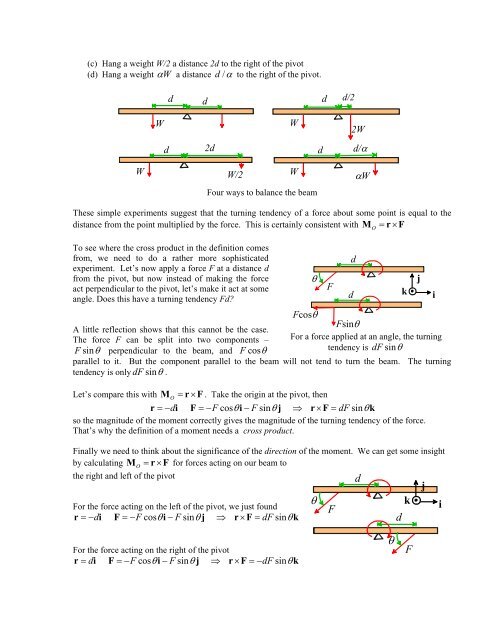Chapter 2 Review of Forces and Moments - Brown University
Chapter 2 Review of Forces and Moments - Brown University
Chapter 2 Review of Forces and Moments - Brown University
You also want an ePaper? Increase the reach of your titles
YUMPU automatically turns print PDFs into web optimized ePapers that Google loves.
(c) Hang a weight W/2 a distance 2d to the right <strong>of</strong> the pivot<br />
(d) Hang a weight α W a distance d / α to the right <strong>of</strong> the pivot.<br />
d<br />
d<br />
d<br />
d/2<br />
W<br />
W<br />
2W<br />
d<br />
2d<br />
d<br />
d/α<br />
W<br />
W/2<br />
W<br />
Four ways to balance the beam<br />
αW<br />
These simple experiments suggest that the turning tendency <strong>of</strong> a force about some point is equal to the<br />
distance from the point multiplied by the force. This is certainly consistent with MO = r×<br />
F<br />
To see where the cross product in the definition comes<br />
from, we need to do a rather more sophisticated<br />
experiment. Let’s now apply a force F at a distance d<br />
from the pivot, but now instead <strong>of</strong> making the force<br />
act perpendicular to the pivot, let’s make it act at some<br />
angle. Does this have a turning tendency Fd?<br />
Fcosθ<br />
Fsinθ<br />
A little reflection shows that this cannot be the case.<br />
The force F can be split into two components – For a force applied at an angle, the turning<br />
F sinθ perpendicular to the beam, <strong>and</strong> F cosθ<br />
tendency is dF sinθ<br />
parallel to it. But the component parallel to the beam will not tend to turn the beam. The turning<br />
tendency is only dF sinθ .<br />
Let’s compare this with MO = r×<br />
F. Take the origin at the pivot, then<br />
r =− di F=−Fcosθi−Fsinθj ⇒ r× F=<br />
dFsinθk<br />
so the magnitude <strong>of</strong> the moment correctly gives the magnitude <strong>of</strong> the turning tendency <strong>of</strong> the force.<br />
That’s why the definition <strong>of</strong> a moment needs a cross product.<br />
Finally we need to think about the significance <strong>of</strong> the direction <strong>of</strong> the moment. We can get some insight<br />
by calculating MO = r×<br />
F for forces acting on our beam to<br />
the right <strong>and</strong> left <strong>of</strong> the pivot<br />
d<br />
j<br />
θ<br />
k<br />
For the force acting on the left <strong>of</strong> the pivot, we just found F<br />
i<br />
r =− di F=−Fcosθi−Fsinθj ⇒ r× F=<br />
dFsinθk<br />
d<br />
θ<br />
F<br />
d<br />
d<br />
k<br />
j<br />
i<br />
For the force acting on the right <strong>of</strong> the pivot<br />
r = di F=−Fcosθi−Fsinθj ⇒ r× F=−dFsinθk<br />
θ<br />
F
















